Species of marsupial
| Hairy-footed dunnart[1] |
Conservation status |
 Least Concern (IUCN 3.1)[2] |
Scientific classification  |
| Domain: | Eukaryota |
| Kingdom: | Animalia |
| Phylum: | Chordata |
| Class: | Mammalia |
| Infraclass: | Marsupialia |
| Order: | Dasyuromorphia |
| Family: | Dasyuridae |
| Genus: | Sminthopsis |
| Species: | S. hirtipes |
| Binomial name |
Sminthopsis hirtipes
Thomas, 1898 |
 |
| Hairy-footed dunnart range |
The hairy-footed dunnart (Sminthopsis hirtipes) is a dunnart that has silver hairs on the soles of it hind feet accompanied by long hair on the side of its sole. It is an Australian marsupial similar to the Ooldea dunnart, with its upper body yellow-brown and lower body white in colour. Its total length is 14.7–18 cm (5.8–7.1 in); its average body length is 7.2–8.5 cm (2.8–3.3 in) with a tail of 7.5–9.5 cm (3.0–3.7 in). Its ear length is 15 mm (0.59 in). It weighs between 13 and 19 g (0.46 and 0.67 oz). Its tail is thin and pinkish-white and can be thickened at the base.
Distribution and habitat
This species inhabits three distinct areas; around Monkey Mia Bay and Kilbarri in Western Australia, a large area where the border of South Australia, Northern Territory and Western Australia converge and a small area between the Northern Territory and Queensland border 100 km north of the South Australian border. Its habitat includes arid and semi-arid woodlands, heath, savannah grasslands.
Social organisation and breeding
The hairy-footed dunnart lives in burrows built by spiders, bull ants and other similar burrowing type species. Not much is known about the breeding cycle but the young are in the pouch by October and juveniles emerge by late April.
Diet
Its typical diet includes mainly small reptiles and arthropods.
References
- ^ Groves, C. P. (2005). Wilson, D. E.; Reeder, D. M. (eds.). Mammal Species of the World: A Taxonomic and Geographic Reference (3rd ed.). Baltimore: Johns Hopkins University Press. p. 36. ISBN 0-801-88221-4. OCLC 62265494.
- ^ McKenzie, N.; Dickman, C. (2016). "Sminthopsis hirtipes". IUCN Red List of Threatened Species. 2016: e.T40544A21948399. doi:10.2305/IUCN.UK.2016-2.RLTS.T40544A21948399.en. Retrieved 12 November 2021.
- Menkhorst, P.; Knight, F. (2001). A field Guide to the Mammals of Australia. Oxford Press. ISBN 0-19-550870-X.
External links
- Australian Biological Resources Study[permanent dead link]
|
|
|---|
| Dasyurini | Dasycercus
(Mulgaras) | - Southern mulgara (D. archeri)
- Brush-tailed mulgara (D. blythi)
- Crest-tailed mulgara (D. cristicauda)
- Ampurta (D. hilleri)
- Little mulgara (D. marlowi)
- Northern mulgara (D. woolleyae
|
|---|
| Dasykaluta | - Little red kaluta (D. rosamondae)
|
|---|
| Dasyuroides | |
|---|
Dasyurus
(Quolls) | - New Guinean quoll (D. albopunctatus)
- Western quoll (D. geoffroii)
- Northern quoll (D. hallucatus)
- Tiger quoll (D. maculatus)
- Bronze quoll (D. spartacus)
- Eastern quoll (D. viverrinus)
|
|---|
| Myoictis | - Woolley's three-striped dasyure (M. leucura)
- Three-striped dasyure (M. melas)
- Wallace's dasyure (M. wallacii)
- Tate's three-striped dasyure (M. wavicus)
|
|---|
| Neophascogale | - Speckled dasyure (N. lorentzi)
|
|---|
| Parantechinus | |
|---|
Phascolosorex
(Marsupial shrews) | - Red-bellied marsupial shrew (P. doriae)
- Narrow-striped marsupial shrew (P. dorsalis)
|
|---|
Pseudantechinus
(False antechinuses) | - Sandstone false antechinus (P. bilarni)
- Fat-tailed false antechinus (P. macdonnellensis)
- Alexandria false antechinus (P. mimulus)
- Ningbing false antechinus (P. ningbing)
- Rory Cooper's false antechinus (P. roryi)
- Woolley's false antechinus (P. woolleyae)
|
|---|
| Sarcophilus | - Tasmanian devil (S. harrisii)
|
|---|
|
|---|
| Phascogalini | | Antechinus | - Tropical antechinus (A. adustus)
- Agile antechinus (A. agilis)
- Fawn antechinus (A. bellus)
- Yellow-footed antechinus (A. flavipes)
- Atherton antechinus (A. godmani)
- Cinnamon antechinus (A. leo)
- Swamp antechinus (A. minimus)
- Brown antechinus (A. stuartii)
- Subtropical antechinus (A. subtropicus)
- Dusky antechinus (A. swainsonii)
|
|---|
| Murexia | - Habbema dasyure (M. habbema)
- Short-furred dasyure (M. longicaudata)
- Black-tailed dasyure (M. melanurus)
- Long-nosed dasyure (M. naso)
- Broad-striped dasyure (M. rothschildi)
|
|---|
| Phascogale | - Red-tailed phascogale (P. calura)
- Brush-tailed phascogale (P. tapoatafa)
|
|---|
|
|---|
|
|
|
|---|
| Sminthopsini | | Antechinomys | |
|---|
| Ningaui | - Wongai ningaui (N. ridei)
- Pilbara ningaui (N. timealeyi)
- Southern ningaui (N. yvonnae)
|
|---|
Sminthopsis
(Dunnarts) | - S. crassicaudata species-group: Fat-tailed dunnart (S. crassicaudata)
- S. macroura species-group: Kakadu dunnart (S. bindi)
- Carpentarian dunnart (S. butleri)
- Julia Creek dunnart (S. douglasi)
- Stripe-faced dunnart (S. macroura)
- Red-cheeked dunnart (S. virginiae)
- S. granulipes species-group: White-tailed dunnart (S. granulipes)
- S. griseoventer species-group: Kangaroo Island dunnart (S. aitkeni)
- Boullanger Island dunnart (S. boullangerensis)
- Grey-bellied dunnart (S. griseoventer)
- S. longicaudata species-group: Long-tailed dunnart (S. longicaudata)
- S. murina species-group: Chestnut dunnart (S. archeri)
- Little long-tailed dunnart (S. dolichura)
- Sooty dunnart (S. fulginosus)
- Gilbert's dunnart (S. gilberti)
- White-footed dunnart (S. leucopus)
- Slender-tailed dunnart (S. murina)
- S. psammophila species-group: Hairy-footed dunnart (S. hirtipes)
- Ooldea dunnart (S. ooldea)
- Sandhill dunnart (S. psammophila)
- Lesser hairy-footed dunnart (S. youngsoni)
|
|---|
|
|---|
| Planigalini | | Planigale | - Paucident planigale (P. gilesi)
- Long-tailed planigale (P. ingrami)
- Common planigale (P. maculata)
- New Guinean planigale (P. novaeguineae)
- Narrow-nosed planigale (P. tenuirostris)
- Orange-headed Pilbara planigale (P. kendricki)
- Cracking-clay Pilbara planigale (P. tealei)
|
|---|
|
|---|
|
|
|
Taxon identifiers |
|---|
| Sminthopsis hirtipes | |
|---|












